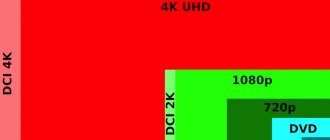What do you need to watch 4K? It is clear that this is not only about having a TV that supports 4K screen resolution. The main component of a home entertainment system is a 4K-compatible TV, and that's clear and obvious.
The price of such a TV cannot be low. But besides the 4K TV itself, some things are needed, for example, 4K content, external 4K devices, connection cables, etc. Let's try to figure out step by step what you need to watch high-quality 4K video at home. So, what do you need to watch 4K?
How to choose a 4K TV
Not all 4K TVs are created equal. Yes, all such TVs support a screen resolution of 3840x2160 pixels, but that's not all. If you have not yet bought a 4K TV for your home, then now is the opportunity to figure out exactly what you need to get the most out of the price-quality ratio.
Note that 4K TVs of 2015 do not contain the latest quality standards in their specifications, so it is worth paying attention to the new 4K TV lines. The main points that you should pay attention to before purchasing a 4K TV are the presence of HDR (High Dynamic Range) and Wide Color Gamut technologies in the specification.
It is possible to get acquainted with the parameters of HDR video. Without these two characteristics, a modern 4K TV will not provide satisfactory picture quality. When choosing a TV, be sure to find out whether the TV has HDR and WCG. Both of these technologies allow you to reproduce high-quality HDR content, and you will enjoy watching it.
The second point worth paying attention to is the technology for dimming the pixels of the screen matrix (Local Dimming). The better the screen dimming, the better the black tones will be reproduced on your TV screen. But it’s worth studying the topic separately.
For example, this indicator is best for OLED screens, but the cost of the TV is very high. Details in the article LED and OLED differences To watch 4K, you need to pay attention to the presence of interfaces in your future 4K TV, at least HDMI 2.0 with support for HDCP 2.2 encryption. Without this, you will not be able to play 4K content from various sources. Most first and second generation TVs do not have such interfaces.
Read about the HDMI 2.0 interface - find out more. If you plan to view HDR content, then the interface version on your TV should be HDMI 2.0a. The article HDMI 2.1 HDR standard briefly talks about all the latest interfaces of this type, although the last one (HDMI 2.1) has not yet been approved.
If you want to watch old movies, buy an expensive TV
Older films were shot with either analogue or digital cameras. With analog everything is clear - we digitize, retouch frame by frame, connect and watch (tedious and expensive). But it initially contains more data than early digital records.
With “digital” it’s generally more difficult. It is impossible to increase the resolution of a digital file in HD - the quality will not increase due to manipulation.
Some manufacturers equip TVs with a software increase in resolution - “upscaling”. Don't confuse upscaling with simple stretching. The first one tries to fill in the missing ones based on the colors of neighboring pixels. The second one does nothing - large squares of the same color remain.
Real life example: I have 2 TVs with UltraHD : LG with upscaling and Hisence without it. You can watch old films only on the first one.
So far, old films are being transferred to 4K very reluctantly (only Hulu and the Japanese are actively working on this). If you don’t want to cry tears of blood from squares on half the screen, choose the right model.
Which player to watch 4K video on?
You need a source of 4K video content to play on a 4K TV. Of course, all 4K TVs can scale images to 4K resolution from “lower” formats, but believe me, all this is not the same... Yes, there are online sources that work through streaming (Internet video broadcasting). These resources include Netflix and Amazon. Netflix and Vimeo services are available in Russia.
This is by far the easiest option to get 4K content, but it won't be the cheapest. If your TV does not support streaming, and this cannot happen by definition, then there are external 4K devices that allow this. An example would be the Roku 4 TV box (review here), which supports a large number of online 4K services. Unfortunately, not all external devices support HDR content - only a 2021 TV needs help here.
Since we're talking about streaming, it's worth noting the required Internet speed for normal 4K video playback. According to some sources, the minimum required speed should be 15 megabits/sec.
To watch 4K, you need to choose a tariff plan with a minimum speed of at least 20 Mbit/sec - these are numbers from practice. If your Internet speed fluctuates or falls below the specified levels, you will experience interruptions in video content. In this situation, it is better to use 1080p “Super HD” video quality or a lower bitrate.
Now about the sad thing, namely about paying for streaming. For example, Netflix's priority subscriptions start at $12 per month. Who doesn’t love free 4K content... But that’s not the case. As a rule, streaming monsters with cheaper plans do not have 4K content. But with an Amazon Prime subscription, anyone gets 4K video in the basic version.
On YouTube, 4K content is still difficult to find (except for short videos) in the public domain, and the service is not yet available on all 4K TVs. In general, "pure" 4K content is a problem at the moment. There is another option - to use an Ultra HD Blu-ray player and corresponding discs as an external source.
They have already been announced and are going on sale. An example of an excellent player is the Samsung UBD-K8500 Blu-ray player. The price of one disc is about $30 US rubles, but they are recorded in HDR, which is a big plus.
4K UHD movies available on disc
It must be said that many users do not understand the point of purchasing this product at all. However, on the World Wide Web there is little more film with the required resolution. And 95% of them posted on torrent trackers are ordinary fakes! To make these rips, video capture of the HDMI output on a UHD player is used.
The resourceful authors of such films, so to speak, even have access to programmatically adding HDR tags to their products. The existence of these offers can be explained very simply: they are generated by the presence of demand. But this has nothing in common with the original discs. For this reason, these rips look like high-quality aspscale Full HD video.
4K content
As you've probably figured out, you specifically only need 4K content. How to find it? To avoid confusion, look for the 4K or UHD label - you definitely can’t go wrong. Nowadays 4K video is already available from Netflix and Amazon, disc producers are trying to put on as many popular films as possible, but it’s worth thinking about - will you want to watch this again?
Key points. Where can I watch 4K movies? You can watch 4K movies through relevant apps on your devices, such as your TV or external device. All of them allow you to install and use additional services.
Do I need to upgrade my 4K video player to watch Ultra HD Blu-ray discs? It all depends on the time of purchase. Yes, all “fresh” players already come with updated software. Those purchased before 2021 will most likely automatically require an update.
What is Ambilight
Ambilight (ambient lighting technology) is a technology invented and patented by Philips that provides background adaptive lighting on the company's television panels .
The system analyzes the color palette of the picture on the screen and turns on a similar glow around the perimeter of the TV. Everything works in dynamic mode and creates the effect of dispersion of the image outside the matrix.
It looks very impressive and allows you to immerse yourself even more in the atmosphere of the film or TV series. In this way, it is possible to visually increase the size of the screen and fill most of the viewer’s view with color.
Unfortunately, other electronics manufacturers are not trying to present their analogues or buy the rights to use Ambilight from the copyright holder. However, with the help of some gadgets from AliExpress you can create something similar.
How to choose the right HDMI cable
All your cables connecting the TV and external device should work well. To watch 4K, you need to make the main connection via a high-speed HDMI cable to transmit a 4K video signal. However, cables marked with earlier standards may not work. Usually, the “correct” manufacturer will include an HDMI cable in the box with the device (does not apply to 4K TVs).
Cable labeling does not use the terminology “HDMI 1.3” or “HDMI 2.0” or “4K HDMI” cable. There are only two types: high-speed (High-Speed) and standard (Standard-Speed). When choosing, try to buy High-Speed. To connect your TV or receiver, you need to clearly know the version of the HDMI ports of your devices. Note that in fact, HDMI 1.4 supports 4k at 30fps.
To watch 4K you need HDMI 2.0 or HDMI 2.0a. You can navigate by the time of purchase of equipment. If you purchased the device in the last two years, then there is a high probability that everything will work correctly. If the equipment was purchased earlier, then you will have to review the connecting cables and purchase the necessary ones.
How to determine the version of the required cable to connect your 4K TV and an external device? Very simple. Look at the back of the device at the connectors; the interface version will definitely be indicated there. If you do not have the operating instructions for the device at hand, you can always find it on the Internet. Read the instructions often the first time after purchasing the device!
Pattern: if your connecting cable does not work, then you will never get a normal picture and sound (this happens very rarely). If you get a 4K signal without distortion, then your connecting cables are fine. A truism that was not worth mentioning. If your cable does not work, use a more recent HDMI cable.
In custody. Do not fall for tricks and markings like “4K HDMI cables” and similar designations - these are fake. Look for the “Premium HDMI Certified” label and everything will be fine.
Smart TV as a source of 4K UHD video content
The Smart TV project was destined to play the role of a panacea for the crisis, the wave of which began to overwhelm both individual manufacturers and television as such in the final stage of the 2000s. The latter lost its status as an operational means of obtaining information, and this applied not only to news.
Using a computer, the user not only had access to the choice of any point of view, but he could now familiarize himself with it at any time convenient for him. There was an active outflow of film and video products to the Internet. To prevent this, they tried to ban torrents, but nothing came of it.
Companies such as Netflix, VooDoo and TiVo became the recipients of income instead of cable network owners. This led to the fact that users began to treat an ordinary TV as an anachronism, which, like a push-button telephone, could provide only one function.
That's when the concept of Smart TV came into being. A lot has been said about how to use it and what it looks like. We will repeat only the main points. The TV has a main menu. Thanks to the presence of widget applications, users are provided with access to online broadcasts, programs and libraries of films provided by online cinemas or providers.
AV receiver
To watch 4K, unfortunately, you will have to think about purchasing a new AV receiver. Many previous models do not allow pass-through to transmit data through the HDMI port (4K signal). If your receiver (a component of a home theater) does not allow this, you need to choose a new one. After purchasing, you will be able to connect a large number of external sources through it to a 4K TV.
Of course, the option remains to directly connect the 4K source to the TV, and send the audio signal through an optical output (for example, like the Roku 4 set-top box) to an amplifier. But this is not an ideal option, although it is quite economical.
Recommendation: when purchasing a new AV receiver, pay attention to compatibility with 4K devices. Some 4K devices, such as the Samsung UBD-K8500, have a second HDMI interface that only transmits audio. This also needs to be taken into account. We talked about such as the McIntosh MX160 Receiver and some others earlier.
Advantages and disadvantages of RGB tape
If you are already convinced that your interior does not have enough multicolor lighting, then it’s time to talk about the pros and cons of connecting RGB LED strip.
The advantages include:
- Easy to install.
- The service life is much longer compared to conventional incandescent lamps. It can reach about 30–50 thousand hours of uninterrupted operation.
- Ease of use, compactness.
- The ability to implement any, even the most unusual design solutions due to the flexibility and use of lighting effects: flickering, changing colors and shades, adjusting brightness, etc.
- Safety achieved due to low voltage consumption.
The disadvantages of connecting an RGB tape include:
- Moisture resistance is low, but it can be significantly increased if you purchase an LED strip with a silicone shell.
- Lack of protection from mechanical damage.
- Reduced color rendering quality compared to white LEDs, since the LEDs used have a relatively low color rendering index.
The characteristics are impressive, the shortcomings can be adjusted, adapting to your conditions and requirements. For example, if it is important for you that the LEDs are well protected from external factors, then use an aluminum profile for installation. If the room in which the LED strip is supposed to be installed has high humidity, then select it taking into account the moisture resistance of the lighting device. In general, think through all the details before purchasing.
Bottom line
In conclusion, I would like to note where we started. To watch 4K, purchasing one 4K TV for your home does not solve the problem of high-quality playback. There is no need to approach this trivially by purchasing a cool 4K TV. The thesis “4K television in every home” is still far from perfect and ultimately comes down to a large sum that will have to be spent.
To achieve exactly high quality 4K, you need to strive for excellent equipment in the complex.
Perhaps you should look at the “last century” with a resolution of 1080i/1080p, and it will not seem so bad in terms of price and quality. And one last piece of advice. At the beginning of the article is the date when it was written. Today the article is relevant. But if you are reading this article after 3 years, then many parameters and prices may change greatly. What do you need to watch 4K2017-06-22T08:52:48+03:00 VoVVideoWhat do you need to watch 4K? It is clear that this is not only about having a TV that supports 4K screen resolution. The main component of a home entertainment system is a 4K-compatible TV, and that's clear and obvious. The price of such a TV cannot be low. But besides the 4K TV itself, some things are needed, for example, 4K content, external...VoVVoV AuthorUltraHD
Video card
Already spent well? These are still flowers! A 4K monitor is only compatible with high-end graphics cards, that is, the very best. Even the AMD Radeon 295X2 produced only 22 FPS at very high settings in Crysis 3, but in Battlefield 4 this figure reached 37 FPS.
In addition to the processing power, to process 8.3 million pixels in a 4K picture, the graphics card must have enough video memory on board. For example, a combination of two Nvidia 780 GTX Ti simply choked in the same Crysis 3, producing only a minimum of 3 FPS. Such a low result is due precisely to the insufficient amount of video RAM.
Thus, ideally, the system should include not only two powerful GPUs, but also 4 GB of video RAM for each of them. The Radeon 295X2 carries 8 GB of video memory, and two Nvidia 780 GTX Ti in SLI mode have only 6 GB. This is where the GTX 780 fails in Crysis 3.
In addition to the mentioned Radeon 295X2, a combination of two Nvidia GTX Titan (not to be confused with the 780 GTX Ti) is suitable. The solution from AMD will hit your pocket by $1,500, two Titans will cost $2,000. If you are not limited in finances, you should definitely take a closer look at the new video monster Nvidia Titan Z with 12 GB of RAM on board at a price of $3,000.










